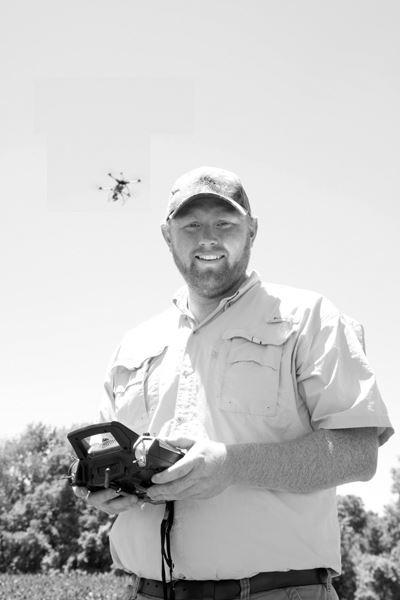|
Scouting The Future
UAVs Will Change How Farmers Scout Fields For Pests
BETTY VALLE GEGG-NAEGER
MidAmerica Farmer Grower
MILAN, TENN.
Agriculture is the main industry where unmanned aerial vehicles (UAVs) will be used, according to Tim Woodward with Tellus Agronomics, headquartered in Orange, Va. Crop scouting will probably be the biggest aspect of that.
“Being able to get a bird’s eye view of the field is critical,” he said. “It saves steps, saves time, saves money. Also, you are able to cover a lot more ground, and that’s the whole goal with agriculture – make more grain and save more money.”
Woodward displayed a quadcopter that is one of two main-frame types of drones. There are the fixed wings which are the planes, and the quads are multi-rotors.
“They have four props that allow them to take off vertically,” Woodward explained. “They’re able to fly to a point and hover there. They can drop down to the canopy level for close-up photos. We can see exactly what’s going on with that plant without having to walk to it. We can pre-program the missions, and it takes off and flies on it’s own. It flies to the pre-programmed points and comes back and lands on it’s own.”
There are numerous safety features on this machine. It’s able to detect when the batteries are low, it will automatically come back and land. It’s able to detect when it’s gone too far, when the signal is lost, it automatically comes back and lands.

Displaying a quadcopter that is one
of two main-frame types of drones is
Tim Woodward with Tellus Agronomics,
headquartered in Orange, Va.
Photo by John LaRose, Jr.
“We’re also able to tell it to come back and land at any time if something has gone wrong.’” he added. “We’re able to put a Go Pro, or other similar camera on the front, that is stabilized. We can put a second camera on the back for aerial mapping. This information can be converted to many different vegetation indices, which can be used for variable rate nitrogen prescriptions, fertilizer, weed management, many, many different aspects. The industry is booming right now.”
Regulations have put a halt on some uses. Woodward expects some things about the uses will change.
“In November we’ll know a lot more about where the industry is going, but until then we do this purely as a hobby. We’re learning more and more about it and we’re hoping that the industry presents itself in such a way that we can use these in every day consulting,” he summed. ∆
BETTY VALLE GEGG-NAEGER: Senior Staff Writer, MidAmerica Farmer Grower
|
|